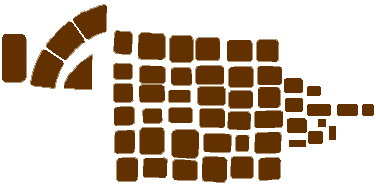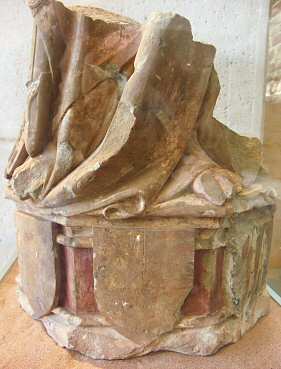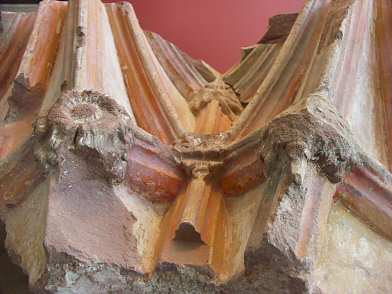|
Index...
|
 he large scale excavation of the priory site presented historians with the first realistic opportunity of modern times to learn about Coventry's beginnings in the Saxon era. The legend of St. Osburga and the foundation of the original nunnery have long been speculated about and moving forward in time slightly, the church endowed by Leofric and Godiva in the 11th century also begged many questions.
he large scale excavation of the priory site presented historians with the first realistic opportunity of modern times to learn about Coventry's beginnings in the Saxon era. The legend of St. Osburga and the foundation of the original nunnery have long been speculated about and moving forward in time slightly, the church endowed by Leofric and Godiva in the 11th century also begged many questions.
The artefacts unearthed during the Phoenix Initiative scheme provided tantalising evidence that there had definitely been occupation of the area during the Saxon period, but frustratingly, no firm proof of the original monastic house of Godiva. This doesn't mean that no part of that structure was found, but simply that positive identification of such materials could not be made with certainty.

One such find which was most interesting, and perhaps the most likely candidate for part of the Saxon church, was uncovered around the base of pier six on the northern arcade of the later cathedral. (See the plan view.) The diagram that I've drawn on the left shows the approximate shape of the stone formation. The stone work was apparently "well dressed" and a greenish coloured mortar was used - a type not seen elsewhere around the site.
It is thought that the remaining part of what was probably a semi-circular set of foundation stones, might possibly have been a small apse for a religious structure. Could Godiva once have really knelt in prayer here? It's a burning question, and unfortunately one that almost certainly will never be answered. One other piece of architecture of particular interest is part of a semicircular arch incorporating a cross, and dated to the Saxon period. It was found to the north of the priory, not "in-situ", but is obviously from an ecclesiastical building. It's of the correct age to be from Godiva's monastic house, but again, no definite link.
Despite this natural disappointment, a wealth of information has been gleaned from this excavation. The structure mentioned above was sandwiched between human remains, and radiocarbon dating of these has placed the building - whatever it's purpose - within a defined timeframe. It was built some time after c870 and demolished before c1160. Given its physical position and a possible dismantling date of mid-12th century, it's perfectly feasible that it remained in use whilst the building of the eastern end of the huge priory cathedral was in progress - and later demolished to make way for the completion of St. Mary's. This, however, is only my own speculation.
 One of the most impressive finds during excavations in 2002 was a piece of art dated to the 1360s and known as the "Apocalypse painting". (Photograph on the right.) It would originally have been a part of a blind arcade in the Chapter House, and would have been only a small fragment of a much more extensive wall painting. Considering its age of over six centuries - the past four being spent covered by soil - it's a remarkably well perserved picture with vivid colours and amazing detail.
One of the most impressive finds during excavations in 2002 was a piece of art dated to the 1360s and known as the "Apocalypse painting". (Photograph on the right.) It would originally have been a part of a blind arcade in the Chapter House, and would have been only a small fragment of a much more extensive wall painting. Considering its age of over six centuries - the past four being spent covered by soil - it's a remarkably well perserved picture with vivid colours and amazing detail.
As can be seen, it forms part of the left side of an arched recess. In fact a second piece was also found, very similar in quality to this one, and effectively a "mirror image" of it, being part of the right side of an arch.
Many human remains - some quite complete - were found buried around the site. Some were carbon dated to the 800s and 900s and so it can be said with some certainty that a settlement was established around here in the late Saxon era. A gold coin from Alfred the Great and many pieces of early pottery were also amongst the finds, adding more circumstantial evidence to Coventry's early development.... but if only we knew more about Godiva's life here.
Although the majority of finds were part of the priory structure, many excavations gave an insight into the life and times of the medieval monks who lived and worked there. These included sewing needles and flute-like musical instruments made out of bone, a wooden ball, leather shoe soles, metal buckles and ornaments, and a wealth of coinage, pottery and utensils which tells us how they cooked and ate in centuries gone by.
The two photos below show the lower remains from a statue of a saint (originally thought by some to be St. George, but more recent thinking makes it likely to be an apostle, possibly St. Paul), and a beautifully ornate carved stone from the pulpit in the refectory.


Website by Rob Orland © 2002 to 2025